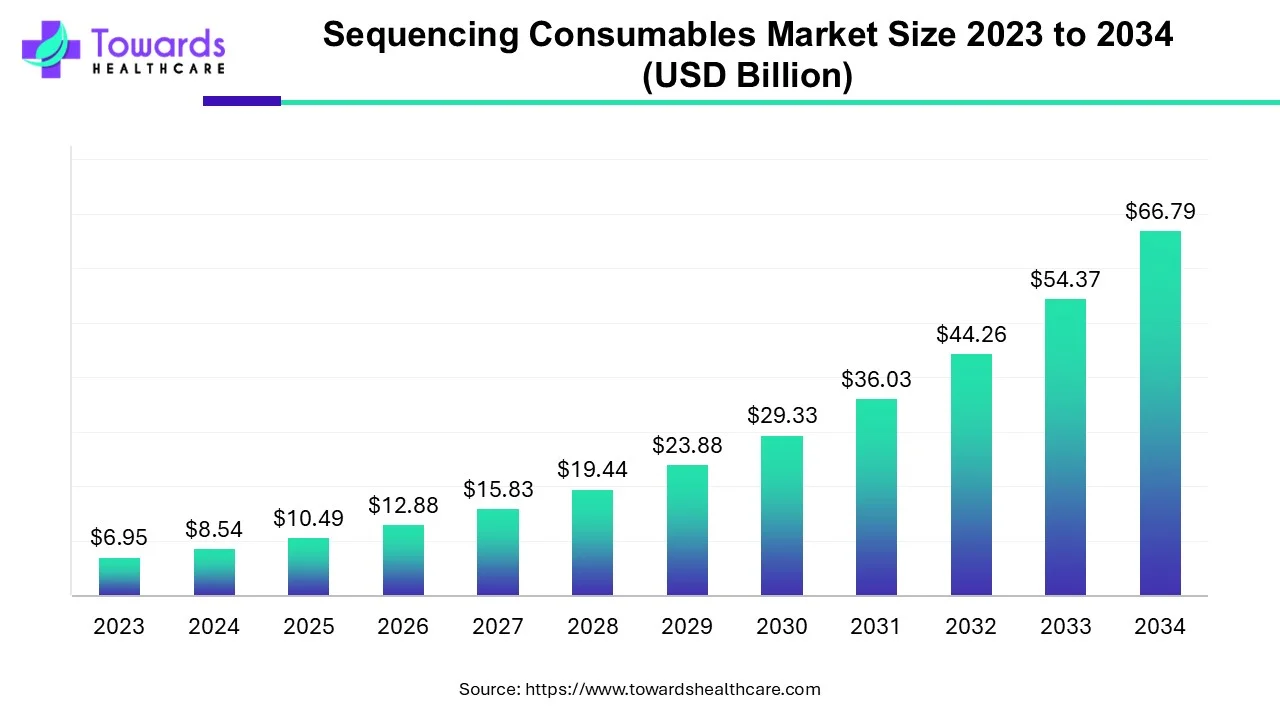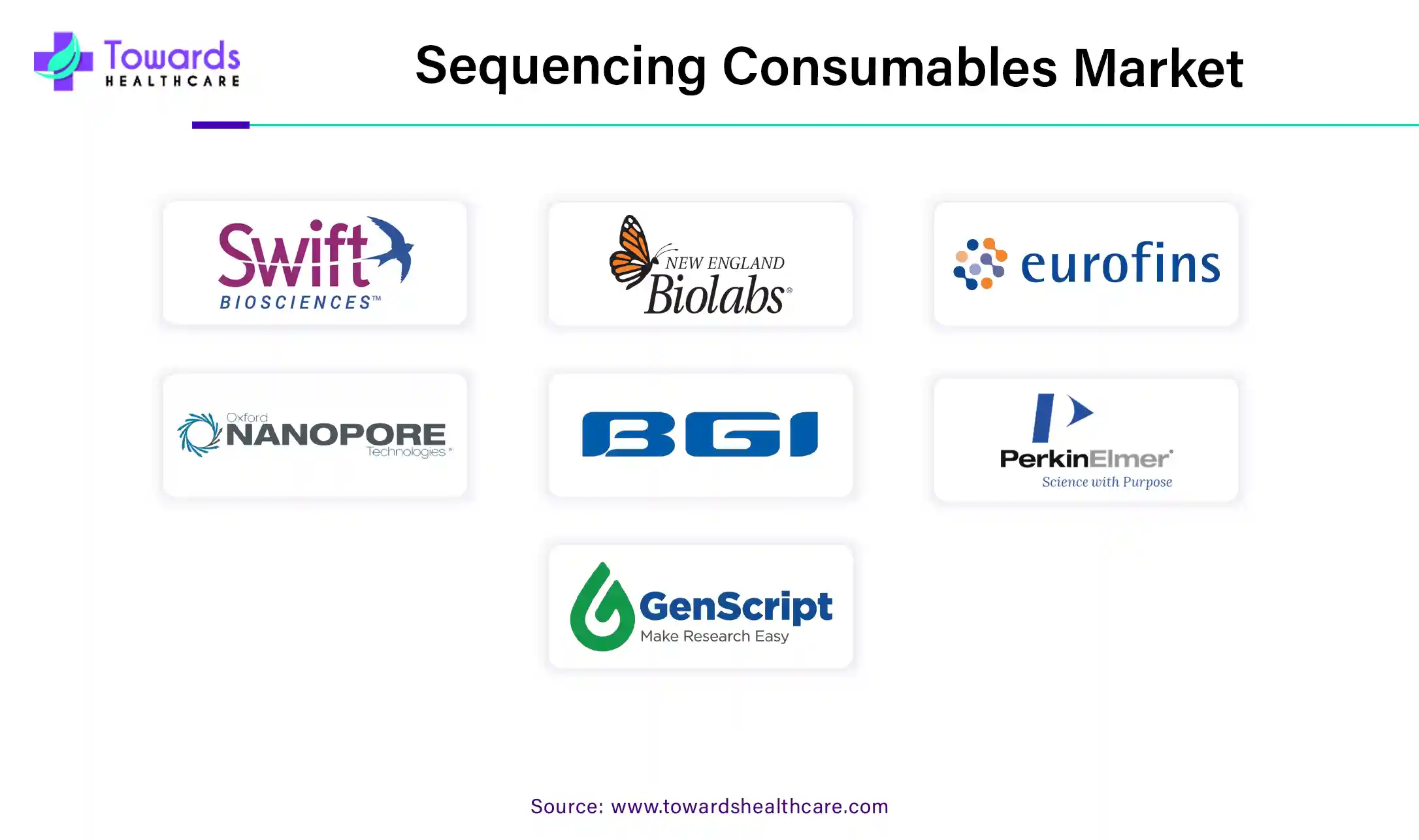April 2025

The global sequencing consumables market size is calculated at US$ 8.54 billion in 2024, grew to US$ 10.49 billion in 2025, and is projected to reach around US$ 66.79 billion by 2034. The market is expanding at a CAGR of 22.84% between 2024 and 2034. Sequencing consumables are in high demand due to the growing demand for genetic sequencing for various purposes such as personalized medicine, disease diagnostics, etc.

The sequencing consumables market provides consumables for RNA and DNA sequencing. Sequencing genetic material is highly useful in the development of new therapeutics, disease diagnostics, gene & cell therapy, personalized medicine, understanding genetic & rare diseases, understanding human evolutions, etc. Hospitals, laboratories, pharma & biotech companies, and research institutions use sequencing consumables for various purposes. Consumables are essential for sequencing as they elevate the accuracy of sequencing. It is highly essential to provide high-quality consumables to increase the accuracy of sequencing. The market’s growth is estimated to increase due to growing interest in personalized medicine and cancer treatment.
In certain fields, including clinical genomics, big and complicated genetic data are processed using a particular kind of AI algorithm called deep learning. The detection of functional DNA sequence elements that are suggestive of gene splicing, large-scale regulatory elements, and gene function seems to be particularly successful when AI time series algorithms are used on genomic sequence data.
For instance,
Technological Advancements: Due to developments in sequencing technology, the sequencing consumables market is growing dramatically. The discipline of genomics has been significantly impacted by the continuous advancement of next-generation sequencing (NGS). Clinical diagnostics, pharmaceuticals, and agriculture are just a few of the industries that have found applications for NGS technology due to their speed and accuracy. Programs that seek to sequence a population with diverse origins also show how genomics is being used more and more in healthcare. Due to the revolution that technology is bringing about in genetic research and its expanding spectrum of applications, the market for sequencing consumables is thus anticipated to increase gradually.
Shortage of Skilled Professionals: The increasing use of these techniques globally has been a key factor in the remarkable expansion of the next-generation sequencing market. However, a number of obstacles, including the dearth of trained workers in developing countries who possess the necessary expertise to operate this sophisticated technology, limit the market's growth to some degree. Further impeding market expansion is the need for significant investments in research programs.
Point of Care Testing: Instead of doing diagnostic tests at a lab bench, physicians may now perform them at the patient's bedside, thanks to technological advancements in recent years. These tools also referred to as "point-of-care testing," are advantageous to patients as well as medical personnel. Faster outcomes translate into less expensive care for the health system and quicker treatment.
By product, the kits segment held the largest share of the sequencing consumables market in 2023. Kits include various essential components for preparing genetic material and sequencing. These kits contain reagents, enzymes, buffers, and other components needed for sequencing. Kits are useful as they provide all the necessary components in one place and do not require separate components, which reduces the chances of errors.
By product, the reagents segment is estimated to grow at the fastest CAGR in the sequencing consumables market during the forecast period. While kits contain various reagents and other components in one pack, reagents are individual enzymes and chemicals used in sequencing. Reagents are useful when researchers want to customize their process and want to use specific reagents. Buying reagents is also useful if needed in large quantities for sequencing. While kits provide convenience, reagents provide flexibility.
By platform, the second-generation sequencing consumables segment held the major share of the sequencing consumables market in 2023. Because second-generation NGS technologies continue to be the most affordable and quickest method of gene sequencing, they are currently the most often employed strategy. Second-generation sequencing (2ndGS) technology produces previously unheard-of volumes of sequence data at very low prices and in a very short length of time. The growing prevalence of 2ndGS technologies is having a significant effect on biomedical research. Whole genome sequencing, target resequencing, identifying infectious agents, characterizing structural and copy number variation, profiling epigenetic alterations, and transcriptome sequencing are examples of common uses.
By platform, the third-generation sequencing consumables segment is estimated to grow at the fastest rate in the sequencing consumables market during the forecast period. Because of single-molecule and real-time sequencing technologies, third-generation sequencing (TGS) has been able to shed light on more genetic illnesses in recent years. Third-generation sequencing, or TGS, is the next generation of DNA sequencing technology that has gained traction in biology as a means of studying genomes, transcriptomes, and metagenomes at a level of detail never before possible.
By application, the cancer diagnostics segment dominated the sequencing consumables market. Millions of people are affected by cancer every year, making it a serious worldwide health concern. For many years, traditional cancer therapies used a one-size-fits-all approach, ignoring the complex genetic differences that cause malignancies. A new age of tailored and focused cancer treatments has been brought about by the development of cancer genetics. In 2005, efforts were made to sequence the genomes of cancer. By 2030, the genomes of hundreds of millions of cancer patients will have been sequenced.
By application, the pharmacogenomics segment is estimated to showcase lucrative growth in the sequencing consumables market during the predicted timeframe. Pharmacogenetics has the potential to be used in medication optimization. With the ability to enhance acceptable polypharmacy and avoid drug-related issues, pharmacogenetics may contribute to bettering the present methods of medication utilization. The advantages of more widespread pharmacogenomic-guided medication prescription might be significant due to the vast number of genetic variations that can impact drug reactions.
By end-use, the hospitals & laboratories segment held the largest share of the sequencing consumables market in 2023. The field of personalized medicine, which involves customizing therapies for each patient according to their genetic composition, has grown in popularity in recent years. Sequencing technologies are quickly making their way into clinical treatment and are now being utilized in research settings. For instance, compared to single mutation testing, sequencing has been shown in many recent case-study reports to give cancer patients a more precise diagnosis and more suitable treatment.
By end-use, the pharmaceutical & biotechnology companies segment is expected to grow at the fastest rate in the sequencing consumables market during the forecast period. The market for next-generation sequencing is being driven by pharmaceutical and biotechnology firms' use of NGS for a number of purposes, such as identifying genetic alterations, comprehending disease causes, and creating tailored medicines. By offering a comprehensive understanding of the genetic foundations of illnesses, NGS makes it easier to develop more individualized and successful treatment strategies.

North America dominated the sequencing consumables market share by 52% in 2023. The region's broad use of next-generation sequencing technology is a result of several reasons. These include government support for genomics research, a well-established healthcare system, and the rising incidence of chronic illnesses. The next-generation sequencing market in the area is expected to increase due to the presence of major market participants and easy access to cutting-edge genomic research technologies.
Additionally, due to developments in genetic research, falling sequencing technology prices, and the growing use of NGS in personalized medicine, the United States topped the North American sequencing consumables market in 2023. NGS is transforming diagnostics by offering thorough insights into genetic variants and mutations. This is especially true in cancer, where it makes exact tumor profiling and tailored therapy possible. The market forecast for next-generation sequencing is also being bolstered by the increase in research efforts pertaining to pharmacogenomics, infectious illnesses, and genetic disorders.
Asia Pacific is estimated to grow at the fastest rate during the forecast period. The causes of this include rising healthcare expenditures, an increasing focus on precision treatment, and an increase in genomic research. Significant expenditures in genomics, extensive research initiatives, and a burgeoning biotechnology sector are the primary forces behind this increase in countries such as China and Japan. Additionally, the Asia-Pacific area is the sequencing consumables market with the quickest rate of growth because of rising awareness, evolving healthcare infrastructure, and government support.
In January 2020, the Department of Biotechnology, Ministry of Science and Technology, Government of India, announced GenomeIndia, a national initiative with a vision. It has set the lofty objective of sequencing the genomes of 10,000 people from all throughout the nation. Around 8000 whole genome sequencing (WGS) data have already been saved in the Indian Biological Data Centre (IBDC), and as of January 2024, the GenomeIndia group has finished sequencing the genomes of over 10,000 people. Ten thousand samples were genotyped jointly in roughly two months, and by June 2024, we want to publish a flagship publication from the partnership.

In June 2024, the Technology Development Coordinating Center (TDCC) of the National Human Genome Research Institute (NHGRI) held the Advances in Genomic Technology Development (AGTD) symposium at The Jackson Laboratory in Farmington, Connecticut. The meeting's goal was to give NHGRI Genome Technology Program grantees an open venue to exchange and talk about important prospects and difficulties for cutting-edge genomic sequencing and synthesis technologies as well as innovative genomic methodologies.
By Product
By Platform
By Application
By End-use
By Region
April 2025
April 2025
March 2025
March 2025